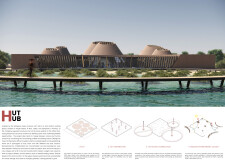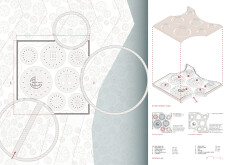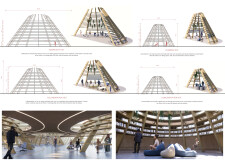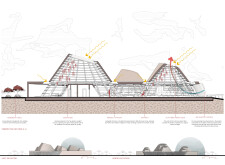5 key facts about this project
## Overview
Situated on Purple Island in Qatar, the Hut Hub is designed to enhance workspace functionality while fostering engagement with the surrounding natural environment. Drawing inspiration from mangrove trees, the concept addresses adaptability and sustainability, promoting a harmonious relationship between indoor and outdoor spaces. The layout comprises a series of distinct circular zones, each serving specific functions—including hospitality, learning, collaboration, and concentration—thus facilitating a varied work experience for users.
## Spatial Strategy
The design incorporates a circular configuration of huts, each tailored to specific activities. The **Hospitality Hut** welcomes users and encourages communal interactions, while the **Learning Hut** provides resources for knowledge sharing. The **Collaboration Hut** is dedicated to teamwork, emphasizing cooperative efforts, and the **Concentration Hut** offers private spaces tailored for focused tasks. The varying heights and upward-curving roofs of these huts optimize natural light penetration and support an intuitive flow, guiding occupants through defined pathways between zones.
## Material Selection
Material choices in the Hut Hub play a crucial role in achieving its aesthetic and ecological objectives. The primary materials employed include reinforced concrete for structural strength, timber for warmth and natural aesthetics, and glass in roof elements to maximize daylight. Additionally, earth-based materials are used for exterior cladding to reflect the textures of the local landscape. This thoughtful integration aims to enhance energy efficiency, leveraging natural light and ventilation conducive to the arid climate of Qatar.
## Environmental Strategies
The project's environmental emphasis is demonstrated through its architecture and site integration. Natural ventilation is facilitated by strategically placed upper openings, enhancing air quality and cooling. The orientation of the building captures sunlight while mitigating heat through indirect light. By incorporating native vegetation, including roof gardens, the Hut Hub supports biodiversity and contributes positively to the local ecosystem.
























































